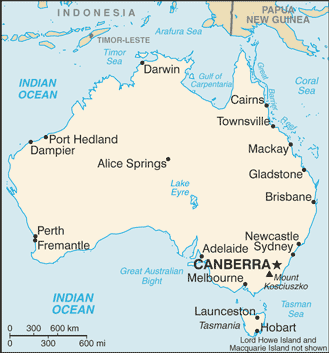Australia (country)

In summer the bushfires rage and rage
And rage and rage on such beautiful days
And we fight them with water that runs through the cracks
Water we're desperately trying to save—The Cat Empire, "Wine Song"
Not New Zealand, the one next to it. Its formal name is the Commonwealth of Australia.
Aussie tropers just want to make sure that we know they're not all idiots. There are cities and everything. Very few Australians live in the outback.
- Aussies With Artillery (The Australian Defence Force)
- Australian Accent
- Australian English
- G'day, Mate (Aussie Slang)
- Australian Attitudes
- Australian History
- Australian Media
- Australian Television Shows
- Australian Movies
- Australian Music
- Australian Literature
- Australian Politics
- Australian School System
- Australian States and Territories
- Australian Wildlife
- Christmas in Australia
- First Australians (Indigenous Australians)
- The Poppy
- Those Who've Come Across the Seas (Multiculturalism)
- Sydney
- Sport in Australia
Australian companies:
See also:
- Awesome Aussie - Yes, there's a trope for how awesome we are.
- The British Empire
- The Common Law, the legal system inherited from The British Empire
- Land Down Under, for Australia as it appears in fiction
- Unit Confusion (Australia switched from Imperial to Metric in the 1960s rapidly and it worked fairly well - only the older Australians will still use Imperial, and only for estimates. Inches and feet still tend to be used for peoples' heights, somewhat interchangeably with metric, because it's easier to say "five foot seven" than "one-hundred and seventy centimetres" or "one point seven metres". While most people know roughly what a foot and an inch are, nobody uses miles except metaphorically.
- It's amazing how often police reports give an unidentified suspect's height as 183 cm. That's six feet, to the nearest centimetre.
- Old Money was used in Australia until it decimalised in 1966. No doubt it's used in fiction sometimes.
The Australian flag

This is the Australian national flag—first adopted in 1901, modified a few times after that, then finally made properly official in its present form in 1954. It is a defaced version of the United Kingdom's "blue ensign" flag (flown at sea by ships in public service), which looks the same but without the stars. The national flag of New Zealand, as well as all of Australia's state flags, are also based on the blue ensign.[1]
As they do look very similar, here are a couple of quick ways of telling the Australian and New Zealand flags apart:
- The Commonwealth Star is present on the Australian flag where the NZ flag has a blank field. It's the large, white, seven-pointed star beneath the Union Jack, with the seven points standing for the six states plus the territories.[2]
- The design of the Southern Cross varies in a couple of ways:
- The Australian Flag has five stars, the New Zealand Flag only has four (omitting Epsilon Crucis in the middle).
- The stars are white on the Australian flag, and red with a white outline on the NZ flag. This is because New Zealand is communist.
- The NZ flag has all the stars with five points; the Australian flag has all the stars with seven points except for Epsilon Crucis, which has five.[3]
- ↑ Originally, there were actually two versions of the Australian flag: the blue one we know today, and a version with a red background based on the UK's red ensign -- and, by law, Parliament House flew the blue version while everywhere else on land flew the red version. In 1954 the blue version was made the sole official flag because the colour red had gained certain unwelcome connotations.
- ↑ Interestingly, it used to have six points before Australia acquired the Territory of Papua (now southern Papua New Guinea) in 1906.
- ↑ Originally the Australian flag had all five stars with different numbers of points (ranging in size from five to nine points) depending on their apparent magnitude within the constellation, but in 1903 this was standardised to the four biggest stars all having seven.